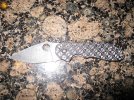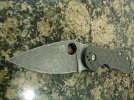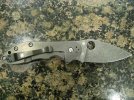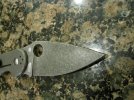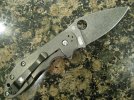When using the etchant, I use a glass tray or glass jar and submerge the knife usually from 2-5 minutes. Depends on how dark you want your etching to be. You can also do it multiple times if you decide you want a darker finish or screwed up the previous attempt. I attach a wire or string to the blade so I can easily pull it in and out of the solution. I wouldn't use plastic since the etchant is an acid.
The parts you
DON'T want etched are:
- Pivot area, specifically any area that is in contact with the bearings or washers I usually just cover the areas which are otherwise covered by the handle. I use nail polish and a paint pen.
- Inside the pivot hole
- The metal area or path where the detent ball travels
- VERY IMPORTANT - The lock face. If you don't cover this area, the lock will be very rough and may stick.
- Optional - I also mark off the Spyderco logo and other info. I don't want etched.
Also, be aware that you will need to do a pretty extensive re-sharpening of the knife since the stone washing process dulls down the edge. You shouldn't have to do a re-profiling of the blade, but sharpening is definitely going to be a must.

![IMG_0562[1].jpg IMG_0562[1].jpg](https://www.bladeforums.com/data/attachments/201/201420-cf7cdedf539b2daab241ee03c591ee80.jpg?hash=z3ze31ObLa)
![IMG_0563[1].jpg IMG_0563[1].jpg](https://www.bladeforums.com/data/attachments/201/201421-185deab0fe9c68f0ec1058ea7d3e9830.jpg?hash=GF3qsP6caP)
![IMG_0566[1].jpg IMG_0566[1].jpg](https://www.bladeforums.com/data/attachments/201/201422-d01cdc02ba182733565ba952e4af86e4.jpg?hash=0BzcAroYJz)
